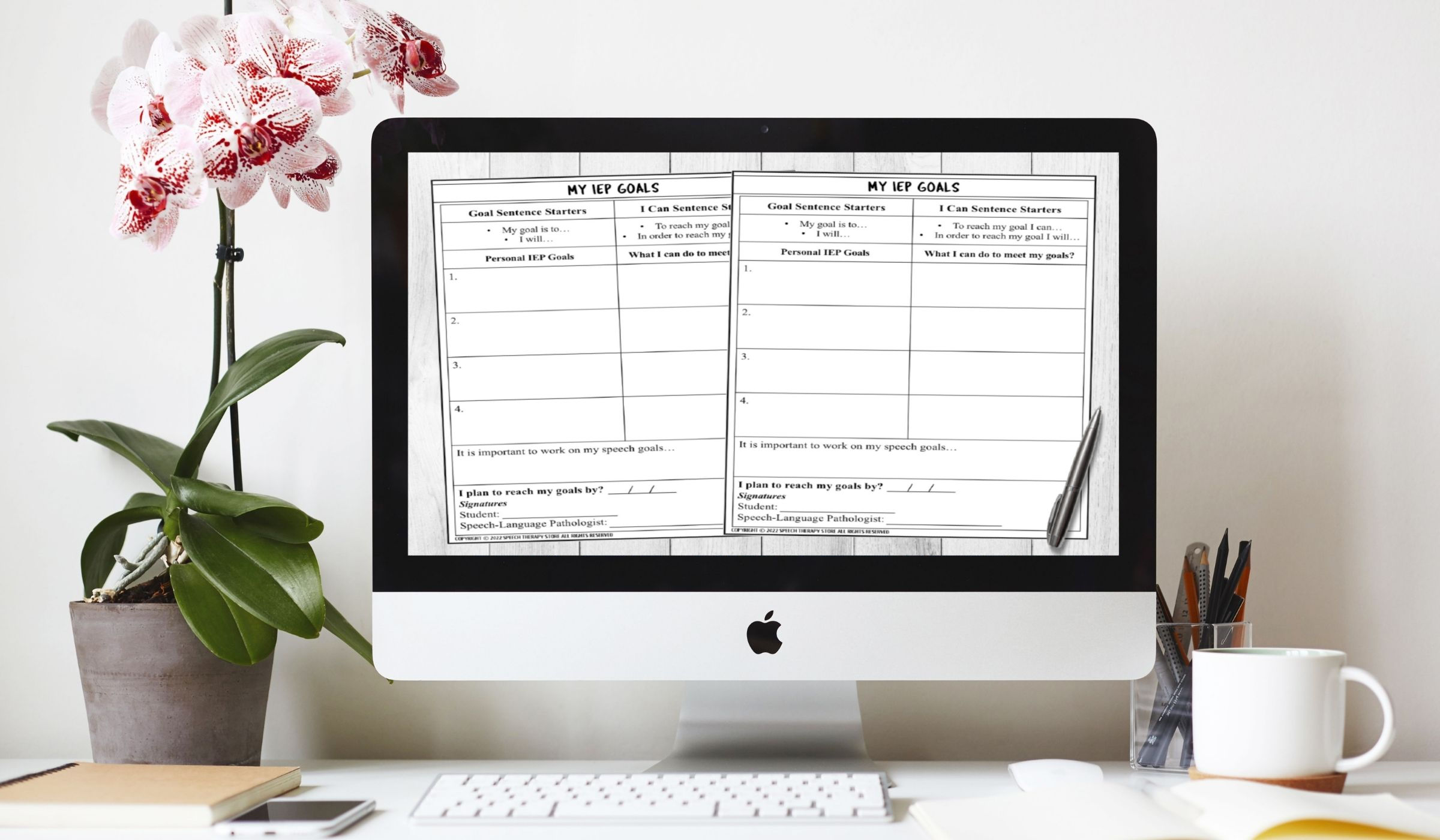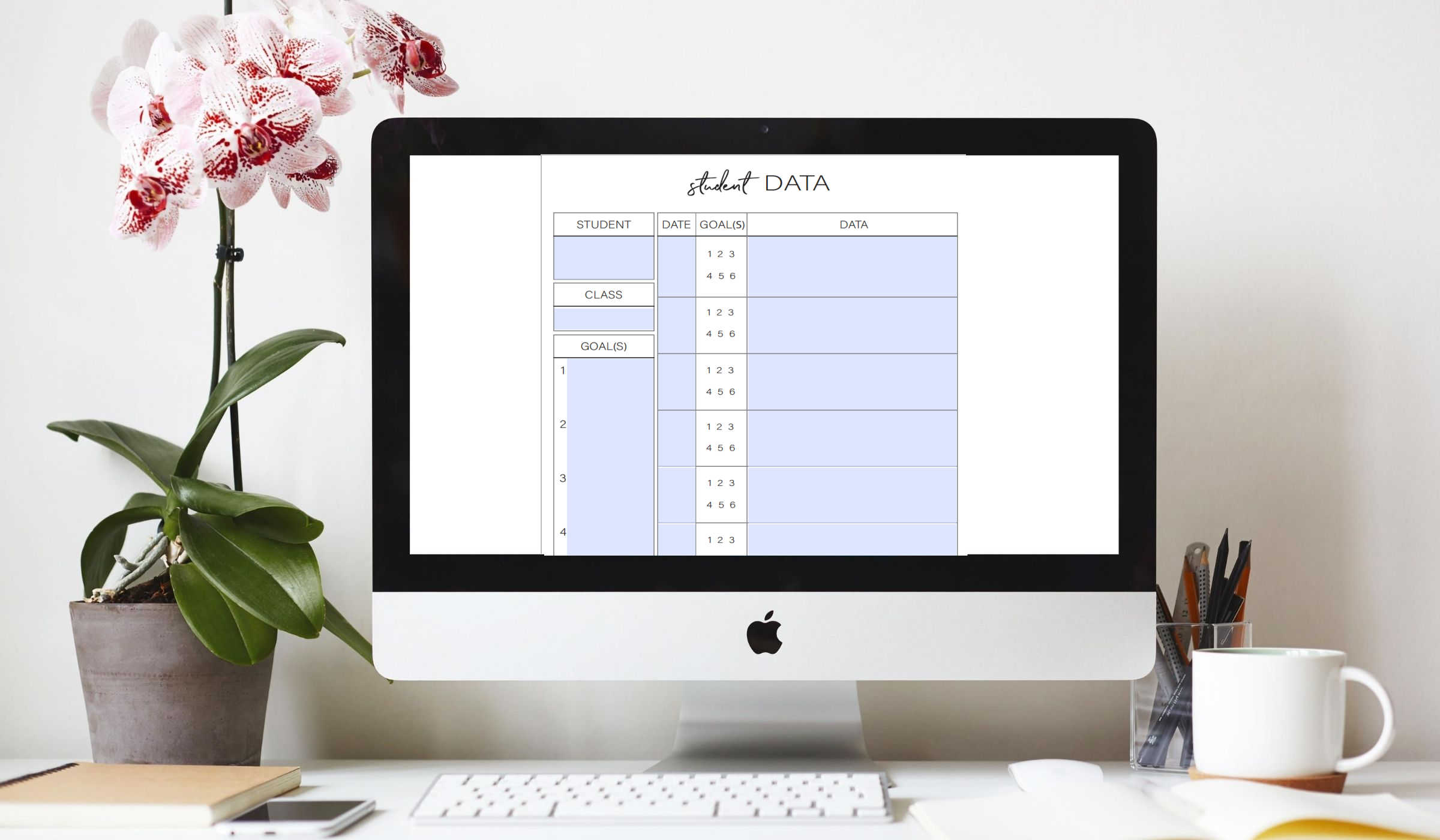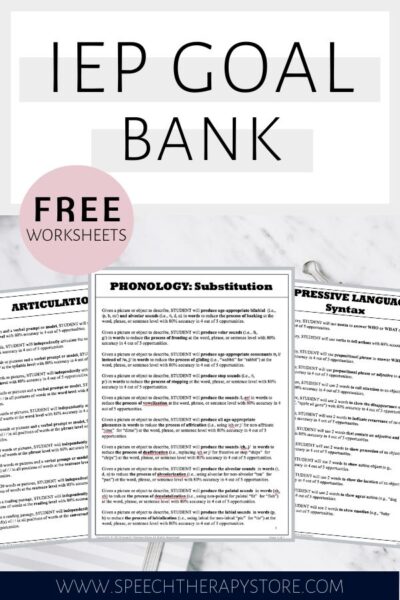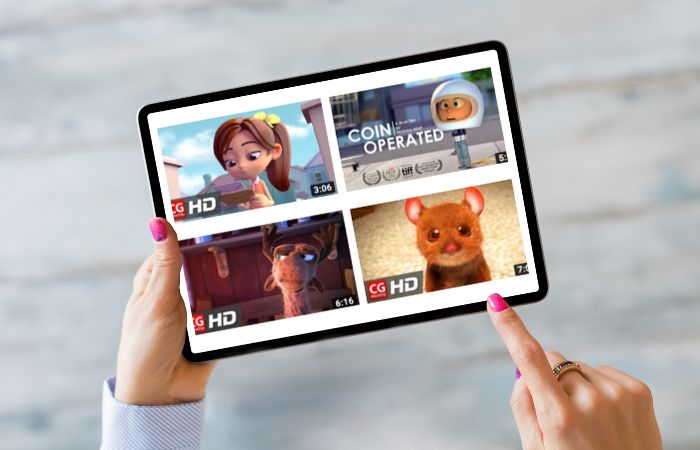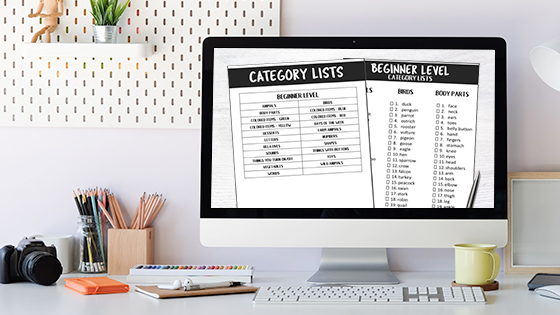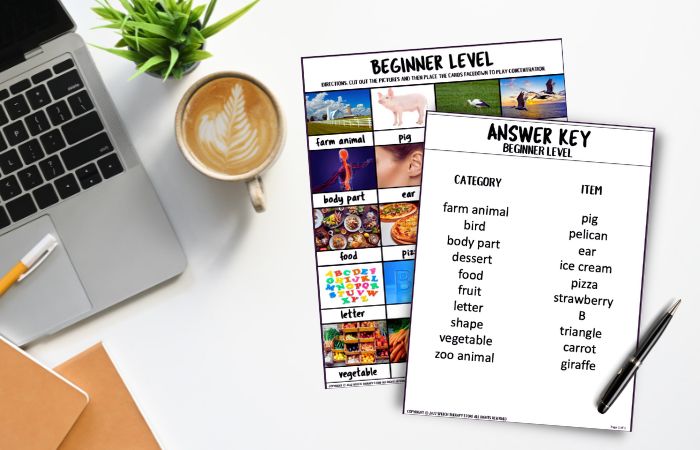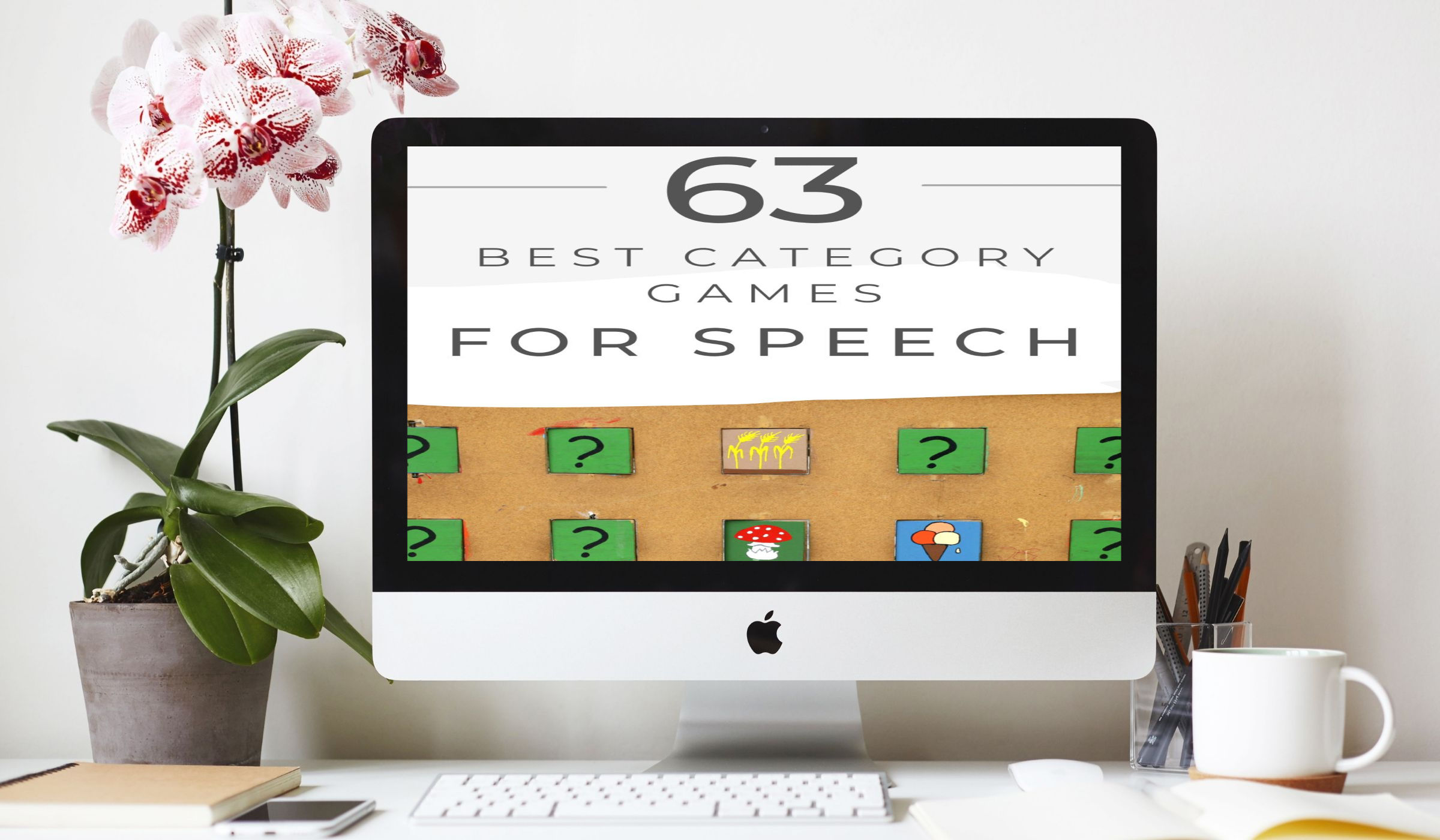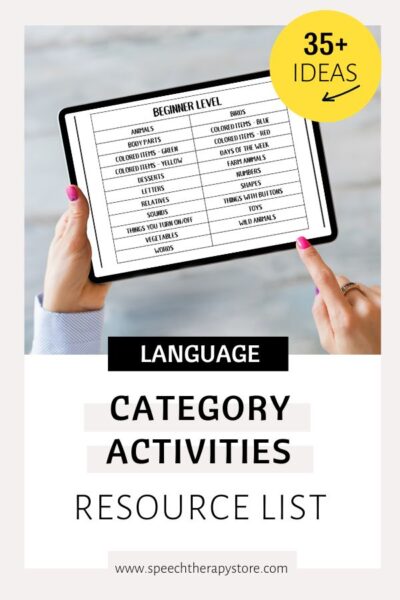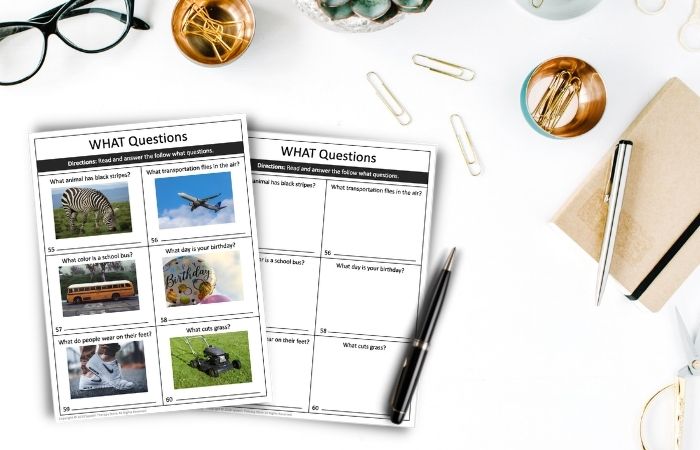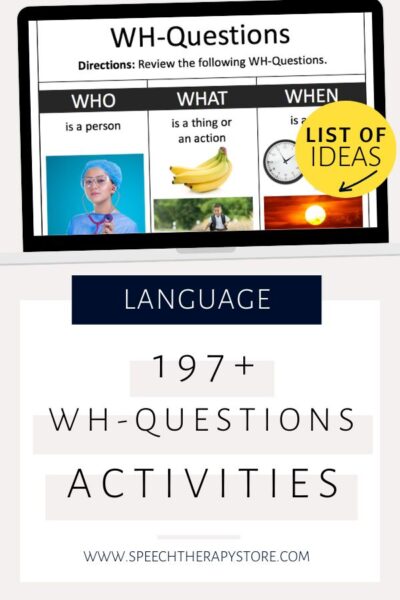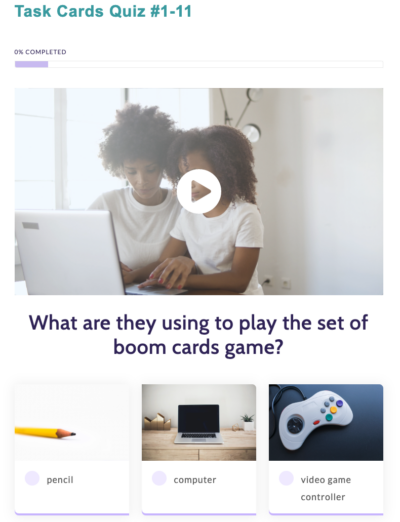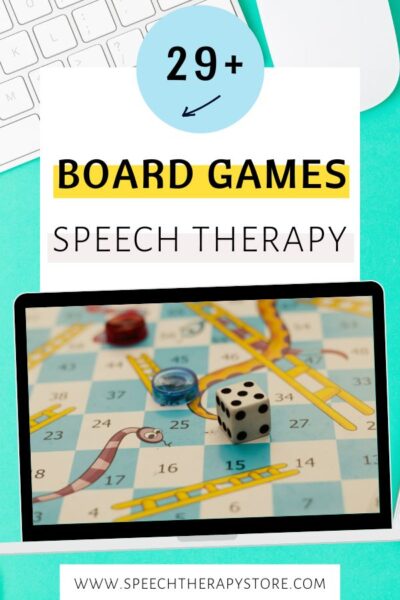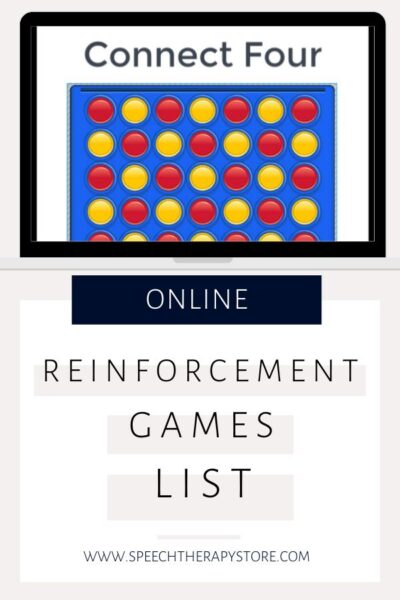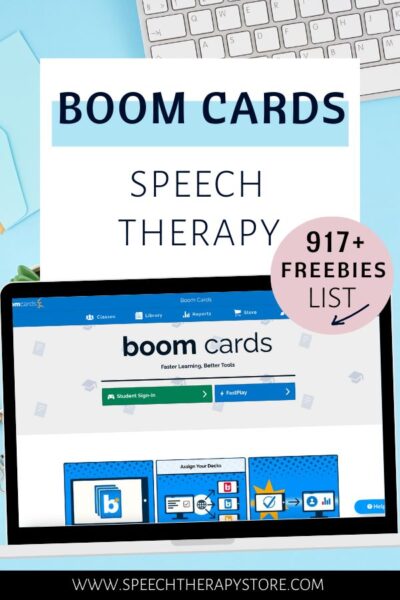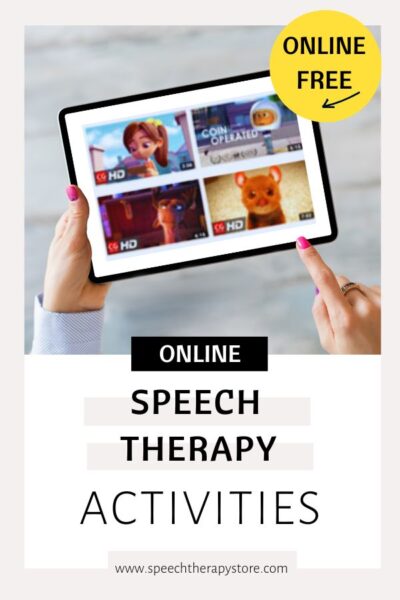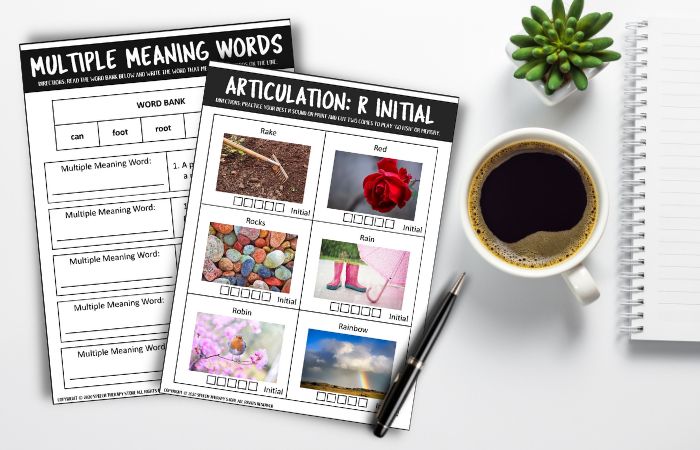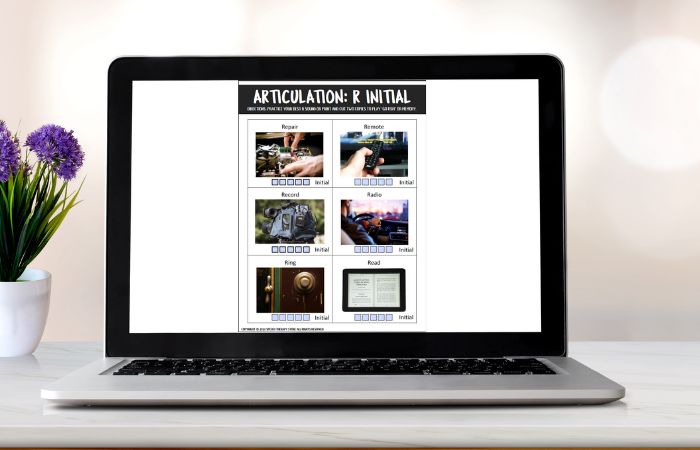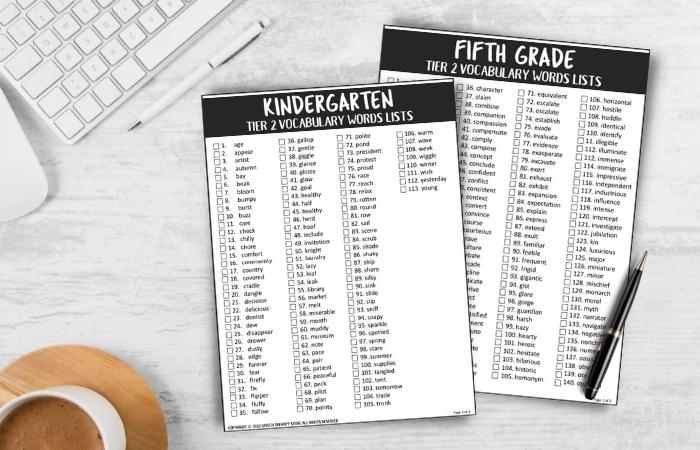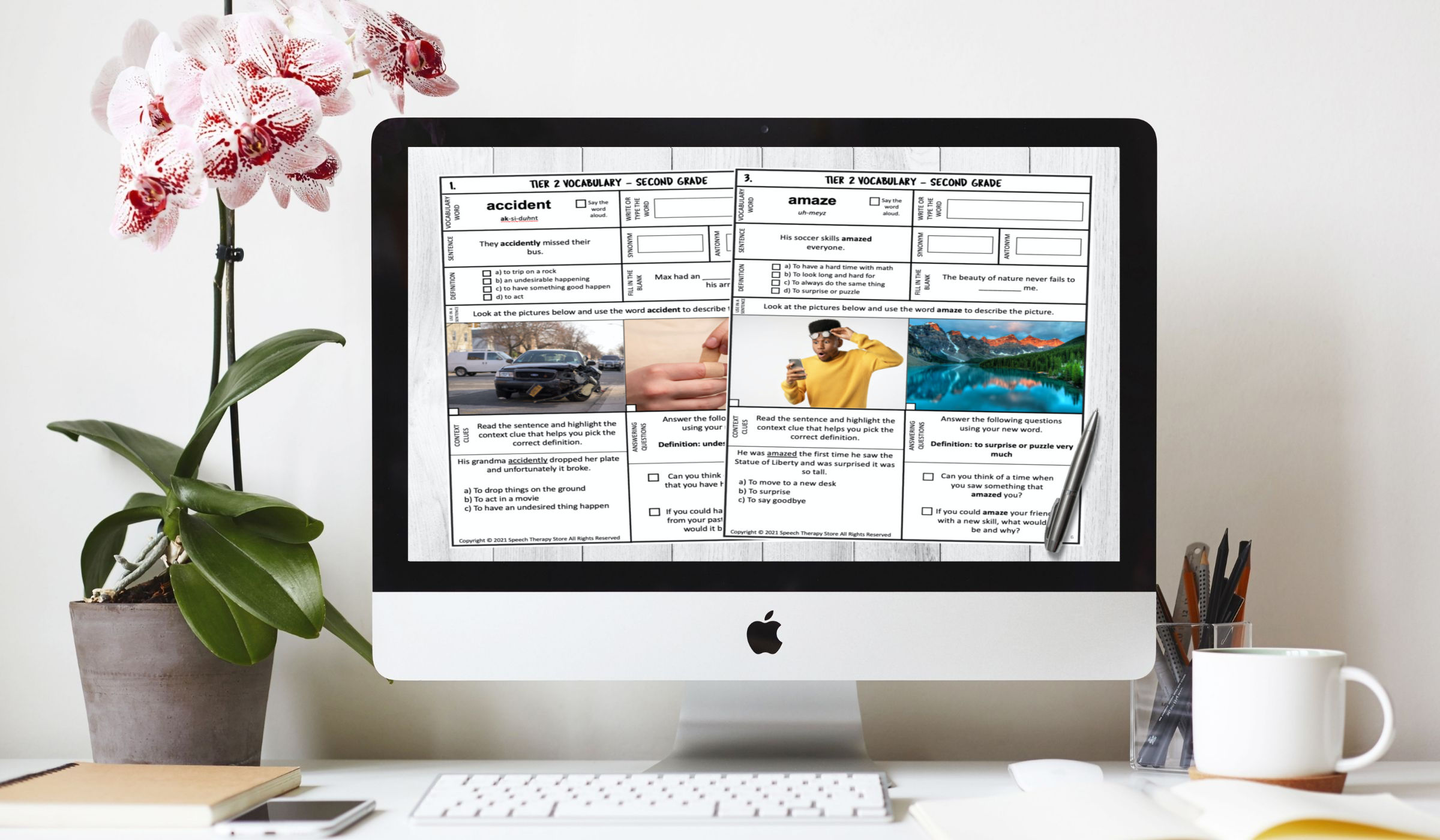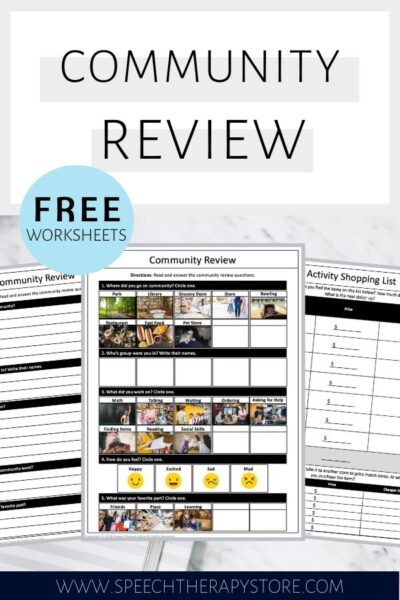If you’re a speech therapist looking for a massive list of receptive language goals for speech therapy this blog post is for you!
Below is a goal bank that you can use for your receptive language delay and hopefully make your workday a little easier today.
Visual Prompts
Using visual cues, such as a picture of an object when working on a child’s receptive language skills can be very helpful for our students with receptive language difficulties. In addition, you can use a helpful verbal cue or verbal prompts to help guide your student to the correct response.
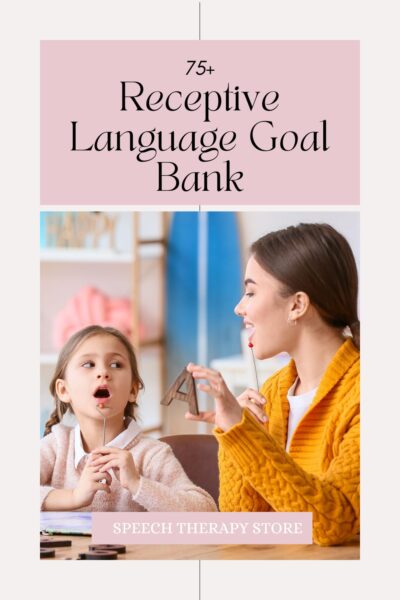
Expressive Language Skills – Receptive Language Goals for Speech Therapy
If you’re a Speech Language Pathologist and are also in need of some IEP goals for an expressive language disorder be sure to check out my complete expressive language therapy goals over at my IEP goal bank.
Long-Term Goals – Receptive Language Goals for Speech Therapy
Below is a list of IEP goals for students diagnosed with a receptive language disorder. Perfect for my fellow Speech-Language Pathologist working in the school setting or private practice settings.
Vocabulary
Given 10 common nouns, STUDENT will identify the correct noun by pointing to the appropriate picture with 80% accuracy in 4 out of 5 opportunities.
Given 10 common verbs, STUDENT will identify the correct verb by pointing to the appropriate picture with 80% accuracy in 4 out of 5 opportunities.
Given 10 common adjectives, STUDENT will identify the correct adjective by pointing to the appropriate picture (size, shape, color, texture) with 80% accuracy in 4 out of 5 opportunities.
Given 3 to 5 pictures, STUDENT will identify the given category items by pointing/grouping pictures into categories with 80% accuracy in 4 out of 5 opportunities.
Following Directions
Given manipulatives (e.g., common objects, paper, pencil, scissors), STUDENT will follow a 1-step direction with 80% accuracy in 4 out of 5 opportunities.
Given manipulatives (e.g., object, paper, pencil, scissors), STUDENT will follow 2-step directions with 80% accuracy in 4 out of 5 opportunities.
Given 2-step directions, STUDENT will follow the directions with 80% accuracy in 4 out of 5 opportunities.
Given manipulatives (e.g., object, paper, pencil, scissors), STUDENT will follow 3-step directions with 80% accuracy in 4 out of 5 opportunities.
Given 3-step directions, STUDENT will follow the directions with 80% accuracy in 4 out of 5 opportunities.
Given manipulatives (e.g., object, paper, pencil, scissors), STUDENT will follow multi-step directions with location modifiers (i.e., spatial concepts) with 80% accuracy in 4 out of 5 opportunities.
Given manipulatives (e.g., object, paper, pencil, scissors), STUDENT will follow multi-step directions with quantity modifiers (i.e., numbers, more/less) with 80% accuracy in 4 out of 5 opportunities.
Given manipulatives (e.g., object, paper, pencil, scissors), STUDENT will follow multi-step directions with quality modifiers (i.e., size, color, shape) with 80% accuracy in 4 out of 5 opportunities.
Given manipulatives (e.g., object, paper, pencil, scissors), STUDENT will follow multi-step directions with pronoun modifiers (i.e., he, she, him, her, they, them) with 80% accuracy in 4 out of 5 opportunities.
Given verbal or written directions, STUDENT will identify the action words in the directions (e.g., “Read the book”…the action word is read) with 80% accuracy in 4 out of 5 opportunities.
Given verbal directions, STUDENT will follow conditional directions (e.g., “If you are wearing a red shirt, stand up.”) with 80% accuracy in 4 out of 5 opportunities.
Answering Questions
Given a story, activity, or classroom discussion, STUDENT will answer “yes or no” questions with 80% accuracy in 4 out of 5 opportunities.
Given a story, activity, or classroom discussion, STUDENT will answer a WH- question or multiple questions (i.e., who, what, when, where, why, how) with 80% accuracy in 4 out of 5 opportunities.
Labeling
Given a verbal prompt, STUDENT will select and hand the clinician the requested object or picture with 80% accuracy in 4 out of 5 opportunities.
Given 3 objects or pictures at a time, STUDENT will select and hand the clinician the requested object or picture with 80% accuracy in 4 out of 5 opportunities.
Given 5 objects or pictures at a time, STUDENT will select and hand the clinician the requested object or picture with 80% accuracy in 4 out of 5 opportunities.
Function
Given 5 objects or pictures at a time and given a function, STUDENT will point to the appropriate object or picture with 80% accuracy in 4 out of 5 opportunities.
Given 5 action pictures at a time and given an action, STUDENT will point to the appropriate action picture with 80% accuracy in 4 out of 5 opportunities.
Association
Given 5 objects or pictures at a time (e.g., ball, bat, car, fork, and ring) and asked what item is associated with … (e.g., with a seatbelt), STUDENT will select an item that is associated with the objects or pictures (e.g., car) with 80% accuracy in 4 out of 5 opportunities.
Given a word verbally, STUDENT will point to the appropriate object or picture associated with that word (e.g., ball/bat, fork/plate) with 80% accuracy in 4 out of 5 opportunities.
Categorizations
Given a category, STUDENT will correctly sort objects/pictures in that category with 80% accuracy in 4 out of 5 opportunities.
Given 3 items in a category and 3 categories to choose from, STUDENT will correctly sort objects/pictures into the appropriate category with 80% accuracy in 4 out of 5 opportunities.
Given 3 different categories, STUDENT will correctly sort objects/pictures into each different category with 80% accuracy in 4 out of 5 opportunities.
Similarities
Given 3 to 5 objects or pictures, STUDENT will select 2 similar objects or pictures with 80% accuracy in 4 out of 5 opportunities.
Given 3 to 5 words verbally, STUDENT will select 2 similar words with 80% accuracy in 4 out of 5 opportunities.
Differences
Given 3 to 5 objects or pictures and an attribute (e.g, color, size, shape, number, texture, etc.), STUDENT will select 1 object or picture that does not share that same attribute with 80% accuracy in 4 out of 5 opportunities.
Given 3 to 5 words and an attribute (e.g, color, size, shape, number, texture, etc.), STUDENT will select 1 word that does not share that same attribute with 80% accuracy in 4 out of 5 opportunities.
Multiple Meaning Words
Given 3 to 5 objects or pictures and a multiple-meaning word, STUDENT will select 2 objects or pictures that represent different meanings of that word with 80% accuracy in 4 out of 5 opportunities.
Given a multiple-meaning word verbally, STUDENT will select 2 correct meanings from a group of 4 written choices with 80% accuracy in 4 out of 5 opportunities.
Attributes
Given 10 objects or pictures and a verbal description of a word, STUDENT will select the correct object or picture to match the given verbal description with 80% accuracy in 4 out of 5 opportunities.
Given 10 words and a verbal description of a word, STUDENT will select the correct word to match the given verbal description with 80% accuracy in 4 out of 5 opportunities.
Prepositions
Given 3 to 5 objects or pictures and a verbal preposition, STUDENT will point to the correct object or picture with 80% accuracy in 4 out of 5 opportunities.
Given object(s) and a verbal or written prepositions directive, STUDENT will follow the directions and act out the preposition using the given object(s) (e.g., “Put the doll under the table.”) with 80% accuracy in 4 out of 5 opportunities.
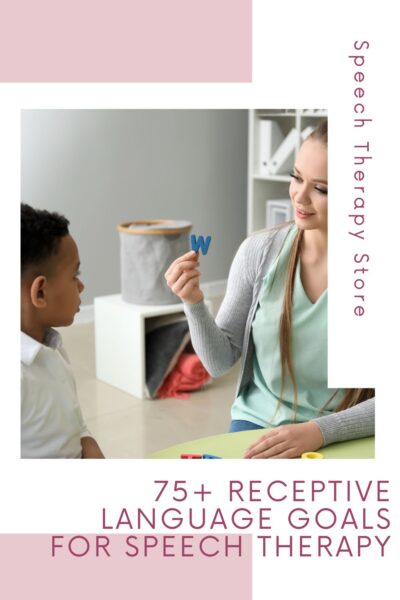
Syntax
Given a verbal question, STUDENT will select the picture of the noun that tells WHO and WHAT with 80% accuracy in 4 out of 5 opportunities.
Given a story read aloud, STUDENT will select the picture of the noun that tells WHO and WHAT with 80% accuracy in 4 out of 5 opportunities.
Given a verbal question, STUDENT will select the picture of the verb that tells the action with 80% accuracy in 4 out of 5 opportunities.
Given a story read aloud, STUDENT will select the picture of the verb that tells the action with 80% accuracy in 4 out of 5 opportunities.
Given a verbal question, STUDENT will select the picture that tells WHERE with 80% accuracy in 4 out of 5 opportunities.
Given a story read aloud, STUDENT will select the picture that tells WHERE with 80% accuracy in 4 out of 5 opportunities.
Given a verbal question, STUDENT will select the picture that tells HOW with 80% accuracy in 4 out of 5 opportunities.
Given a story read aloud, STUDENT will select the picture that tells HOW with 80% accuracy in 4 out of 5 opportunities.
Given a two-word phrase that calls attention to an object or picture (e.g., “that car”, “her toy”), STUDENT will answer “yes or no” if the phrase describes the object or picture accurately with 80% accuracy in 4 out of 5 opportunities.
Given an object or picture and a phrase that shows the disappearance (e.g., “crackers all gone”, “no cookie”), STUDENT will answer “yes or no” if the phrase describes the object or picture accurately with 80% accuracy in 4 out of 5 opportunities.
Given an object or picture and a phrase that shows the recurrence (e.g., “more crackers”), STUDENT will answer “yes or no” if the phrase describes the object or picture accurately with 80% accuracy in 4 out of 5 opportunities.
Given an object or picture and a phrase that contains an adjective and a noun (e.g., “red shoe”, “big ball”), STUDENT will answer “yes or no” if the phrase describes the object or picture accurately with 80% accuracy in 4 out of 5 opportunities.
Given an object or picture and a phrase that shows possession (e.g., “Dad’s cat”, “girl’s shoe”), STUDENT will answer “yes or no” if the phrase describes the object or picture accurately with 80% accuracy in 4 out of 5 opportunities.
Given an object or picture and a phrase that uses action object form (e.g., “Tie shoe”, “read book“), STUDENT will answer “yes or no” if the phrase describes the object or picture accurately with 80% accuracy in 4 out of 5 opportunities.
Given an object or picture and a phrase that indicates the location (e.g., “pencil down”, “car outside”), STUDENT will answer “yes or no” if the phrase describes the object or picture accurately with 80% accuracy in 4 out of 5 opportunities.
Given an object or picture and a phrase that uses agent action form (e.g., “boy jump”, “girl eat”), STUDENT will answer “yes or no” if the phrase describes the object or picture accurately with 80% accuracy in 4 out of 5 opportunities.
Given an object or picture and a phrase that shows an emotion (e.g., “girl sad”, “man angry”), STUDENT will answer “yes or no” if the phrase describes the object or picture accurately with 80% accuracy in 4 out of 5 opportunities.
Given an object or picture and a phrase to achieve a desired end (e.g., “shoe on”, “go home”), STUDENT will answer “yes or no” if the phrase describes the object or picture accurately with 80% accuracy in 4 out of 5 opportunities.
Given an object or picture and a phrase to achieve a desired end (e.g., “shoe on”, “go home”), STUDENT will answer “yes or no” if the phrase describes the object or picture accurately with 80% accuracy in 4 out of 5 opportunities.
Given a phrase or sentence that includes articles (e.g., “a”, “an”, “the”, and “some”), STUDENT will answer “yes or no” if the phrase or sentence uses the articles accurately with 80% accuracy in 4 out of 5 opportunities.
Given a phrase or sentence that includes adjectives (e.g., “this”, “that”, “these”, and “those”), STUDENT will answer “yes or no” if the phrase or sentence uses the adjectives accurately with 80% accuracy in 4 out of 5 opportunities.
Given a phrase or sentence that includes plurals (e.g., s, es) and irregular plural nouns, STUDENT will answer “yes or no” if the phrase or sentence uses the plurals accurately with 80% accuracy in 4 out of 5 opportunities.
Given a phrase or sentence that includes possessive nouns (e.g., “the girl’s bike”), STUDENT will answer “yes or no” if the phrase or sentence uses the possessive accurately with 80% accuracy in 4 out of 5 opportunities.
Given a phrase or sentence that includes subject pronouns (e.g., “I”, “he”, “she”, “you”, “we” “they”), STUDENT will answer “yes or no” if the phrase or sentence uses the pronoun accurately with 80% accuracy in 4 out of 5 opportunities.
Given a phrase or sentence that includes object pronouns (e.g., “me”, “him”, “her”, “you”, “us”, “them”), STUDENT will answer “yes or no” if the phrase or sentence uses the pronoun accurately with 80% accuracy in 4 out of 5 opportunities.
Given a phrase or sentence that includes possessive pronouns (e.g., “my/mine”, “his”, “her/hers”, “your/yours”, “our/ours”, “their/theirs”), STUDENT will answer “yes or no” if the phrase or sentence uses the pronoun accurately with 80% accuracy in 4 out of 5 opportunities.
Given a phrase or sentence that includes reflexive pronouns (e.g., “myself”, “himself”, “herself”, “yourself”, “yourselves”, “ourselves”, “themselves”), STUDENT will answer “yes or no” if the phrase or sentence uses the pronoun accurately with 80% accuracy in 4 out of 5 opportunities.
Given a phrase or sentence that includes present progressive verb tense (e.g., “The man is running”, “The girls are waving”), STUDENT will answer “yes or no” if the phrase or sentence uses the verb tense accurately with 80% accuracy in 4 out of 5 opportunities.
Given a phrase or sentence that includes past progressive verb tense (e.g., “The man was running”, “The girls were waving”), STUDENT will answer “yes or no” if the phrase or sentence uses the verb tense accurately with 80% accuracy in 4 out of 5 opportunities.
Given a phrase or sentence that includes present tense “s” and “es” marker (e.g., “The boy jogs”, and “The bee buzzes”), STUDENT will answer “yes or no” if the phrase or sentence uses the tense accurately with 80% accuracy in 4 out of 5 opportunities.
Given a phrase or sentence that includes “have” and “has” (e.g., “The boy has a dog”, and “The girls have ice skating”), STUDENT will answer “yes or no” if the phrase or sentence uses the tense accurately with 80% accuracy in 4 out of 5 opportunities.
Given a phrase or sentence that includes regular past tense (e.g., “The dog jumped”), STUDENT will answer “yes or no” if the phrase or sentence uses the tense accurately with 80% accuracy in 4 out of 5 opportunities.
Given a phrase or sentence that includes irregular past tense (e.g., “The boy ran”), STUDENT will answer “yes or no” if the phrase or sentence uses the tense accurately with 80% accuracy in 4 out of 5 opportunities.
Given a phrase or sentence that includes reflexive pronouns (e.g., “myself”, “himself”, “herself”, “yourself”, “yourselves”, “ourselves”, “themselves”), STUDENT will answer “yes or no” if the phrase or sentence uses the pronoun accurately with 80% accuracy in 4 out of 5 opportunities.
Given a phrase or sentence that includes present progressive verb tense (e.g., “The man is running”, “The girls are waving”), STUDENT will answer “yes or no” if the phrase or sentence uses the verb tense accurately with 80% accuracy in 4 out of 5 opportunities.
Given a phrase or sentence that includes past progressive verb tense (e.g., “The man was running”, “The girls were waving”), STUDENT will answer “yes or no” if the phrase or sentence uses the verb tense accurately with 80% accuracy in 4 out of 5 opportunities.
Given a phrase or sentence that includes present tense “s” and “es” marker (e.g., “The boy jogs”, and “The bee buzzes”), STUDENT will answer “yes or no” if the phrase or sentence uses the tense accurately with 80% accuracy in 4 out of 5 opportunities.
Given a phrase or sentence that includes “have” and “has” (e.g., “The boy has a dog”, and “The girls have ice skating”), STUDENT will answer “yes or no” if the phrase or sentence uses the tense accurately with 80% accuracy in 4 out of 5 opportunities.
Given a phrase or sentence that includes regular past tense (e.g., “The dog jumped”), STUDENT will answer “yes or no” if the phrase or sentence uses the tense accurately with 80% accuracy in 4 out of 5 opportunities.
Given a phrase or sentence that includes irregular past tense (e.g., “The boy ran”), STUDENT will answer “yes or no” if the phrase or sentence uses the tense accurately with 80% accuracy in 4 out of 5 opportunities.
SEE ALSO: 432+ Free Measurable IEP Goals and Objectives Bank
Speech Therapy Goals – Short-Term Goals Objectives
I know every district has different ways it requires their objectives to be written, but typically my district wanted us to reduce either the number required or the percentage of achievement.
Here are a few examples to help get you started.
If we take a sample goal: Receptive Language Goals for Speech Therapy
“Given 3 to 5 objects or pictures and an attribute (e.g, color, size, shape, number, texture, etc.), STUDENT will select 2-3 objects or pictures that do not share that same attribute with 80% accuracy over 3 out of 4 consecutive sessions.”
- Reduced Number or Trials Required: The objective might be, “Given 3 to 5 objects or pictures and an attribute (e.g, color, size, shape, number, texture, etc.), STUDENT will select 1-2 objects or pictures that do not share that same attribute with 80% accuracy over 3 out of 4 consecutive sessions.”
- Reduce Percentage of Accuracy: The objective might be, “Given 3 to 5 objects or pictures and an attribute (e.g, color, size, shape, number, texture, etc.), STUDENT will select 2-3 objects or pictures that do not share that same attribute with 70% accuracy over 3 out of 4 consecutive sessions.”
- Reduce Difficulty of Task: The objective might be, “Given 2 to 3 objects or pictures and an attribute (e.g, color, size, shape, number, texture, etc.), STUDENT will select 1 object or picture that does not share that same attribute with 80% accuracy over 3 out of 4 consecutive sessions.”
- Reduce Number of Sessions of Accuracy: The objective might be, “Given 3 to 5 objects or pictures and an attribute (e.g, color, size, shape, number, texture, etc.), STUDENT will select 2-3 objects or pictures that do not share that same attribute with 80% accuracy over 2 out of 4 consecutive sessions.”
(Meaning out of 4 therapy sessions in a row. They used 3 to 4-word utterances 2 out of 4 or 50% of the time in order to mark that goal mastered.)
As the speech pathologist, you are the specialist and you know your students and child’s ability best though, so just take the goals and simplify them into achievable steps for your child’s specific receptive language weaknesses.
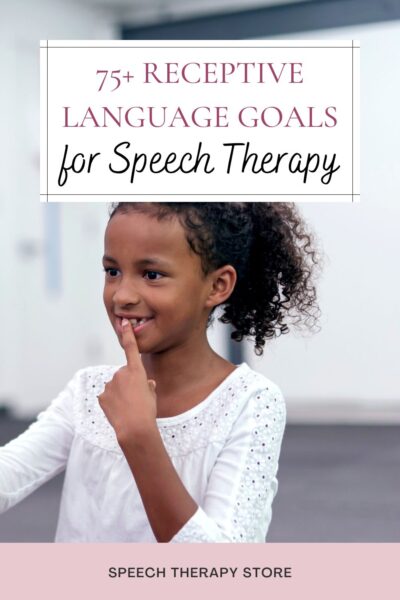
Data Collection – Receptive Language Goals for Speech Therapy
If you’re a classroom teacher or speech pathologist in need of data tracking forms while working on your student’s receptive goals for speech-language therapy then be sure to check out my IEP goal data tracking for progress monitoring forms.
Or if you simply want a list of data sheets to choose from then be sure to check out my list of 35 free speech therapy data sheets roundup.
Measurable Goals – Receptive Language Goals for Speech Therapy
Are you also looking for other speech goals? If so, be sure to check out my master list of IEP goals here.
This list of goal writing ideas also includes the following speech pathology goals:
- Social Skills – Social Interaction
- Facial Expressions
- Body Language
- Figurative Language
- Final Consonants
- Prepositional Phrase
- Context Clues
- Main Idea
- Slow Rate
- Articulation Goals (Single Word Level, Phrase Level, Sentence Level, and Conversation)
- Communication Device – Nonverbal Communication
These are just a few of the possible goal combinations listed on this master list of over 432 IEP goals.
SEE ALSO: 193+ Multiple Meaning Words Grouped by Grade + Free Worksheets
Typical Development – Receptive Language Goals for Speech Therapy
Here is a great resource to review the typical receptive language communication milestones.
- Speech & Language Development Norms by Freedom With Speech – Grab these developmental norms for both receptive language and expressive language.
Receptive Language: Free Activities List
Are you in need of additional free receptive language activities? Then you’ve come to the right place because I’ve done the searching for you!
Check out the following free resources for even more activities to help get you started on your child’s receptive language goals.
Complex Sentences
Here are some freebies to work on your child’s complex sentences.
- Complex Sentence Guided Practice by Teacher’s Pet Vibes Heather Huffman – Have your students practice how to break down a complex sentence.
- Complex Sentence Writing Template {Freebie} by Nicole Allison – Use this writing template to create complex sentences. The best part this freebie comes with 3 different levels!
Expressive Language Difficulties
If you have students who are also working on their expressive language skills be sure to check out these free resources below to help with their expressive language problems.
31 Best Wordless Videos to Teach Problem Solving, Answering WH-Questions, Story Retell/Sequencing, and Making Predictions/Inferences by Speech Therapy Store – This fun activity is perfect for story sequencing and retelling of a story.
133+ Categories List for Speech Therapy by Speech Therapy Store – Working on categorization is another great expressive language skill. Here is a complete list of categories broken down into different levels.
141+ Categories for Concentration {Free Printables!} by Speech Therapy Store – Who doesn’t love the game concentration or memory? Here are 4 free printables to play concentration or memory while working on categorization.
63+ Best Category Games for Speech Therapy by Speech Therapy Store – Check out this list of the best category games for your next therapy session.
35+ Activities to Teach Categories for Speech Therapy by Speech Therapy Store – Here is a list of great activities to use when teaching categorization!
Short Story
Another strategy to work on syntax and receptive language development is to use short stories.
- Free Fictional Short Stories for Listening Comprehension by Talking with Rebecca – Use this resource to work on multiple different targets – wh questions, inferences and predictions, or context clues, yes/no questions, and vocabulary.
- Short Stories & Pictures Writing Prompts, 2 Writing and 2 Response Options by readfactor club – Grab this free resource and read the short stories and then answer wh questions or practice story retelling.
Answer Questions
If you have any students working on answering questions be sure to check out these free resources.
179+ Free Speech Therapy WH Questions Printable by Speech Therapy Store – You won’t want to miss this awesome free printable pdf with real photos!
197+ WH-Questions Activities List by Speech Therapy Store – If you’re in need of a ton of different daily activities be sure to check out my complete list.
31+ What Questions for Speech Therapy + Wordless Videos by Speech Therapy Store – If you have students working on “what” questions I’ve created 3 interactive quizzes with flash cards that are perfect for my special education students.
31 Best Wordless Videos to Teach Problem Solving, Answering WH-Questions, Story Retell/Sequencing, and Making Predictions/Inferences by Speech Therapy Store – This is one of my all-time favorite resources that I’ve ever made on this website. It’s perfect for a small group setting and it takes a difficult task for some of our students and turns it into a fun activity. This lesson plan was used on a regular basis in my therapy room!
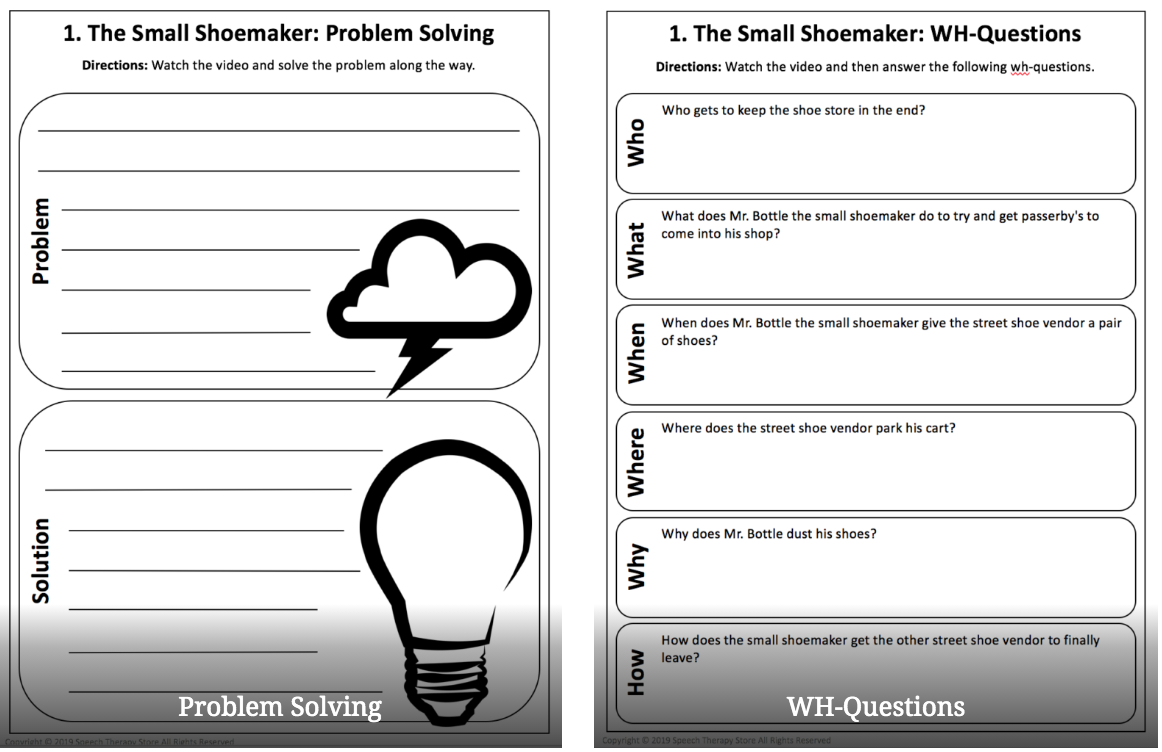
253+ Yes or No Questions for Speech Therapy by Speech Therapy Store – This is a great activity to work on functional communication of answering yes or no questions. It comes with real pictures providing minimal cues to help aid our students’ language development.
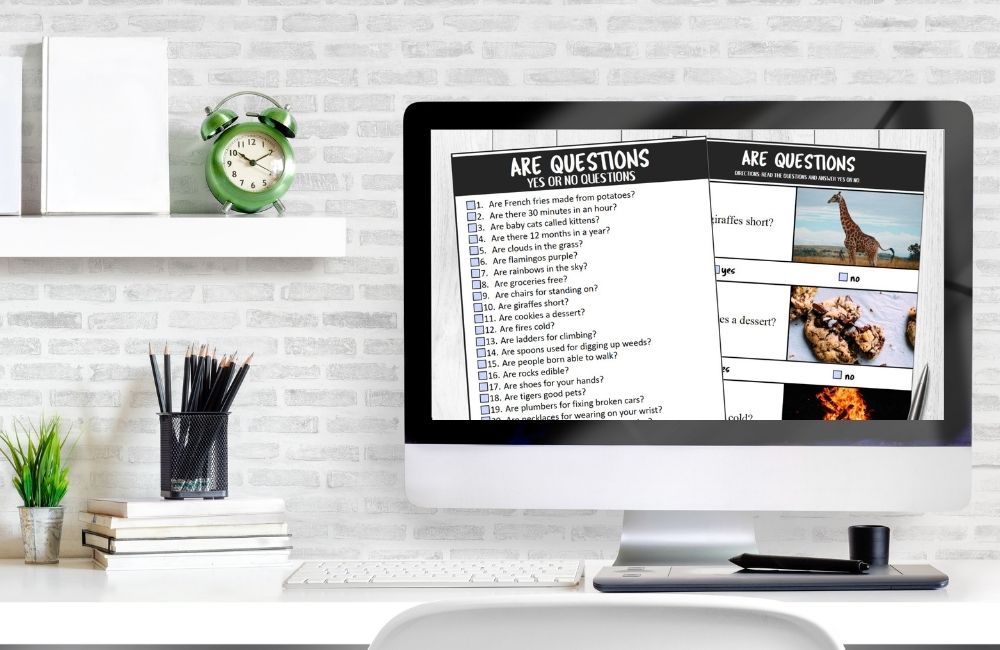
Play Games
Do you have a child or student who loves to play games in therapy? Here are a few of my best resources for games to work on your child or student’s receptive language skills.
29+ Best Speech Therapy Board Games by Speech Therapy Store – You won’t want to miss this list of board games that are perfect for speech therapy along with different ways in which you can use the games within your next therapy session.
21 Best Reinforcement Games for Speech Therapy and Teletherapy by Speech Therapy Store – Here is a list of my favorite reinforcement games that are all digital resources.
917+ Best Free Boom Cards for Speech Therapy by Speech Therapy Store – If you have a child or student who loves Boom Cards you won’t want to miss this blog post that is divided into different skill areas and has a complete section just for receptive language.
41 Free Online Speech Therapy Activities by Speech Therapy Store – Here is a complete list I created of different online resources that would be perfect for a digital therapy session or for a student who is highly motivated by using the computer for therapy.
Structured Language Activities
The first step I like to use when working on receptive language skills is to start with a structured activity.
Best FREE Interactive PDF for Speech Therapy All-in-One by Speech Therapy Store – This resource is amazing for anyone looking for a complete receptive bundle that covers multiple skills, such as Yes/No Questions, WH-Questions, Pronouns, Synonyms, Antonyms, Categories, Regular/Irregular Past Tense Verbs, Compare/Contrast, Describing/Attributes, & Multiple Meaning Words.
Technology Bundle Freebie by Speech Therapy Store – Here is the same amazing bundle as the one above but this bundle is centered around a technology theme!
Vocabulary Word
If you have students working on their vocabulary skills here are a few resources that you might find helpful for your special needs students.
2,000+ Core Tier 2 Words + PDF List by Speech Therapy Store – Here is an amazing list of tier 2 words divided by grade to give you a great list of vocabulary words to work through.
17 Best Vocabulary Goals for Speech Therapy + Activities by Speech Therapy Store – If you’d love 14 free sample pages of my complete comprehensive treatment plan for tier 2 vocabulary words, you’ll want to check out this blog post!
Correct Sentence
Another fun structured activity is to have your students practice correcting a sentence.
- Free Daily Sentence Editing / Correcting Worksheets by The Teaching Rabbit – Have your students practice fixing sentences with these 10 pages.
- Freebie Fix Em Up No Prep Sentences for Students to Edit and Correct by Loving Life with Little Learners – Grab this freebie and have your students start correcting the sentences.
SEE ALSO: IEP Goal Bank Posts
Early Intervention
Here are a few activities that are perfect for your young children.
- Hot Cocoa Concepts No Print for Receptive Basic Concept Skills Distance Learning by Beth Sies Creations for SLPs – This resource is perfect for targeting basic receptive concepts, such as size, negation, color, prepositions, and concepts.
- No Print Receptive and Expressive Categories by The Speech Whisperer – Have some fun while you work on categories with this free resource. Plus it’s digital allowing you to save paper and ink!
Grocery Store
At the high school, I used to work at we had a life skills classroom and we would take the students to the grocery store to work on the child’s unique needs in the real world.
- 7+ Free Community Outings Printables Life Skills by Speech Therapy Store – This free resource includes a social story, store vocabulary, expected / unexpected behaviors, if/then situations, an activity shopping list example + a blank version, and a community review page.
In Conclusion: Receptive Language Goals for Speech Therapy
I hope you found this list of receptive language goals for speech therapy helpful.
Feel free to spend less time creating your own receptive language goals and copy and paste the above goals.
If you’re a family member wondering if your child has a receptive language delay then be sure to reach out to a local Speech-Language Pathologist to receive more formal assessments.
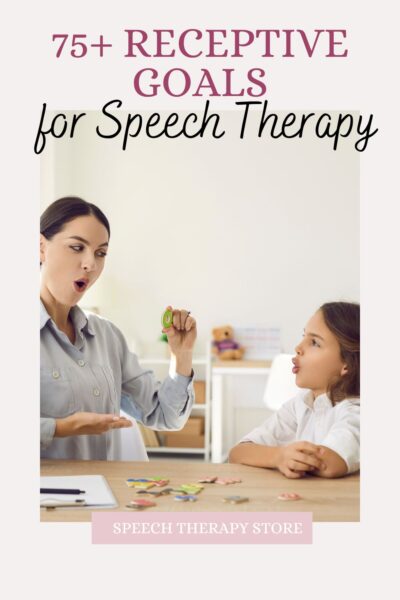
Want Even More Receptive Language Goals for Speech Therapy?
- 917+ Best Free Boom Cards for Speech Therapy
- 31 Best Wordless Videos to Teach Problem Solving
- 179+ Free Speech Therapy Wh-Questions Printable
- 133+ Categories List for Speech Therapy
- Best IEP Resources
Want the Best of the Bests?
Be sure to check out our most popular posts below!

